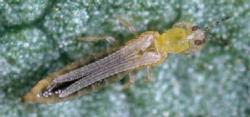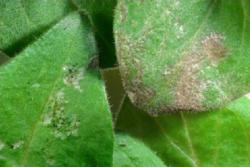Unused stories
Pest of the Month - Thrips
These bugs are bad news...


There are types of thrips specific to particular types of plants - gladiolus, iris, avocado, bean, citrus, melon, pear, onion, privet, toyon and Cuban laural. One of the most common pest types is the Western flower thrips, Frankliniella occidentalis, which favors many herbaceous ornamentals (impatiens, petunia), vegetables (cucurbits, pepper), fruits (grape, strawberry) and some shrubs and trees (rose, stone fruit).
Although thrips have wings, they tend to rely on wind currents to carry them as much as several miles, or to be transported on infested plants. As poor fliers, they tend to spread slowly through a plant or garden. Their lifecycle can be extremely short, development from egg to adult may take as little as two weeks during warm weather, resulting in multiple generations each year.
Managing thrips can be a challenge – there are no pesticides that provide complete control. Insecticides are often not effective due to the pests’ tiny size and mobility, their feeding deep within flower buds or new growth and their protected egg and pupal stages. Prevent infestation through good cultural and sanitation practices, and where appropriate, use barriers like row covers to exclude them. Limit excessive applications of nitrogen fertilizers as these actually promote higher populations of the pests (along with aphids). If cultural controls are not effective, then physically removing infested or damaged parts should be a first step in an overall integrated pest management approach that includes encouraging beneficial predators like green lacewings and minute pirate bugs. You can also try a strong spray of water to knock them off plants. If the plant is otherwise healthy, it should outgrow the damage.
Use this link, http://ipm.ucanr.edu/QT/thripscard.html, for more information from the UC IPM website.
By Nanette Londeree
Photos of thrips damage to foliage, and adult Western Flower Thrips courtesy of ANR Repository
